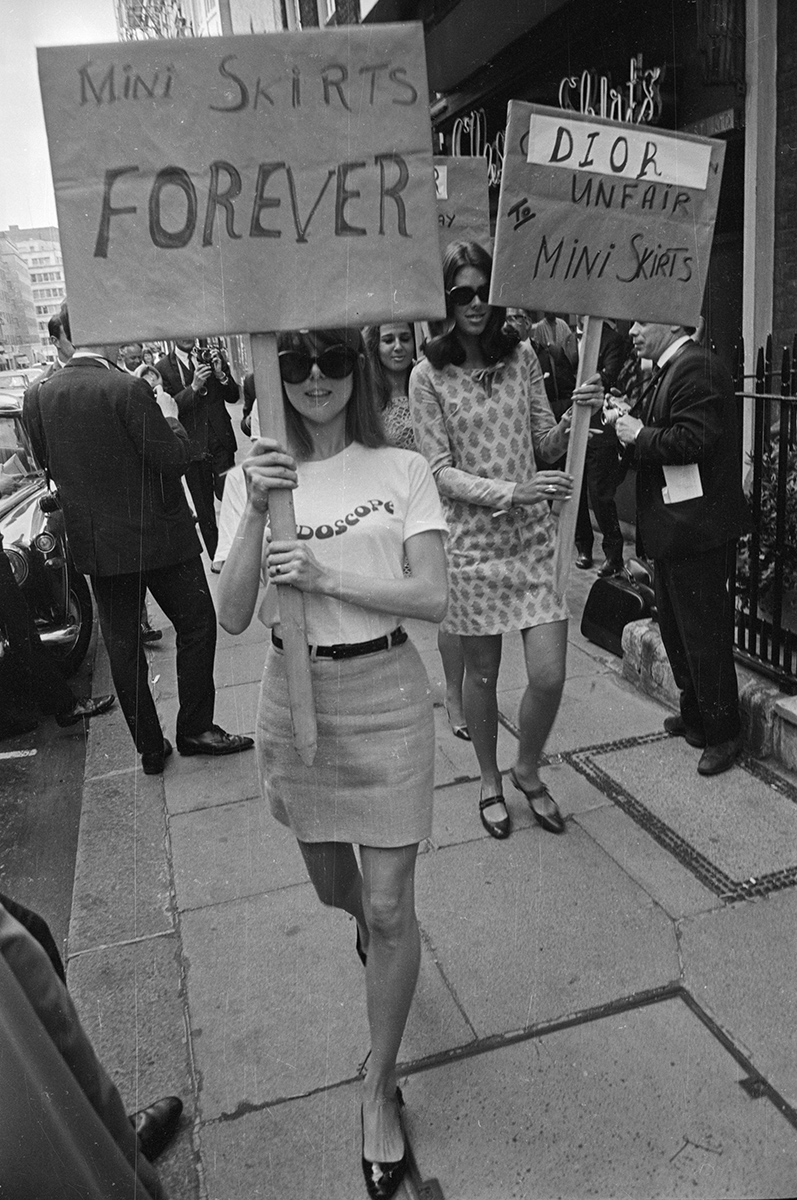Some were forbidden pieces. Others did not look good in the overall picture: they were too bold, too provocative, too excessive, too masculine. And for a long time, none would be considered necessary, elegant, or even cool. They were “crossed out” from the list.
Some were forbidden pieces. Others did not look good in the overall picture: they were too bold, too provocative, too excessive, too masculine. And for a long time, none would be considered necessary, elegant, or even cool. They were “crossed out” from the list.

©Getty Images
The Mini skirt
"Obscene" and "disgusting". That’s how the smallest skirt in history started its winding path. If, on one hand, its invention is attributed to André Courrèges, on the other hand, it is the name of Mary Quant (United Kingdom, 1930) that pulsates when we refer to the piece of cloth that won the title of miniskirt. The decade was the 60's and the city of London was the epicenter of the world. In conversation with American Vogue, Quant argued that it were “King’s Road girls” the ones responsible for the creation of that piece so simultaneously modern and bold. She also said in an article published in The Telegraph - in her defense - that perhaps Courrèges could after all have created the miniskirt first: “But if he did, nobody wore it.” In those crazy swinging sixties (at least when it comes to women), the French maison Dior decided that there was no place on its catwalks for raised hems. The answer was a protest by the British women's group Society of the Protection of Mini Skirts that considered “unfair” the treatment given to that piece. In the posters you could read: “Miniskirts are forever”. And they really wore. Didn't they?
Hoodie
Of the most recent incidents where the hoodie had centre stage happened in 2012, in the USA, and involved the death of a teenager - who, unfortunately, was wearing a hoodie. On the night of February 26, Trayvon Martin, a 17-year-old student was shot and killed in the state of Florida. In his hands he carried a packet of Skittles and an Ice Tea. On his body, a hoodie and jeans. Moments before he was shot, the sniper, George Zimmerman, had made a call to 911 in which he said that a young man in a "black or gray hoodie" looked "suspicious". In the days following the event, Fox News personalities like Geraldo Rivera and Bill O'Reilly, blamed Martin's outfit for his death, discussing the racial debate that the role of the hoodie stands for. "The reason why Trayvon Martin died is because he was dressed in a 'certain way', and not because of the color of his skin", said O’Reilly on the O’Reilly Factor show. And he added: "If Trayvon Martin had put on a blazer and a tie, like what you are wearing tonight, Mr. West, I think that Zimmerman would not have raised any suspicion. But he wore a hood and that's how gangs dress. And therefore, he caught his eye”. In the face of a wave of protest that was raised around the death of that teenager, the hoodie ended up becoming an emblem of the (long) fight against racism that permeates American society, as well as a symbol to end it once and for all.
Bikini
In a world just out of a violent Second World War, to recover lost freedom was something to be celebrated. It was the hot season of 1946 and, on the French beaches, women folded their bathing suits – something like two suffocating pieces - in order to show a little skin, until then hidden by the plentiful fabrics that constituted their unusual swimsuits. Louis Réard, engineer, designer and subsequently considered the father of the “smallest swimsuit in the world”, as described by Vogue Portugal in an article regarding this piece, noticed this detail and was prepared to make history. Réard thus invented the bikini: a swimsuit so small it was able to fit in a matchbox. The piece was considered by the Vatican as a prototype of “sin” and was forbidden on Spanish, Italian and Australian beaches. Its design that, in addition to showing the belly, had the “Indecency” to reveal part of the butt, made the life of the french engineer harder,
since no professional model wanted to wear it. But on the 5th of July that same year, in the Molitor Piscine in Paris, the exotic dancer Micheline Bernardini walked, for the first time, Réard’s bikini, becoming the first woman to wear it in public. In the following weeks, she got more than 50,000 fan letters.
High heels
The history of high heels began in the court of Louis XIV. Beyond the usual motives - ensuring superiority – high heels were a way to overshadow his low height (1.60 cm). And, of course, only the members of his court were allowed to wear them. But let’s forget royalty, which is beside the point. In the 60s, a 180 degree turn occurs. Women are no longer struggling to wear a pair of high heels, but to get rid of it. In 1968, a group of feminists joined the Freedom Trash Can demonstration, in order to get rid of everything they considered torturous: among them, high heels. Plot twist, and fast forward to 2016, when a London receptionist is let go from work after refusing to wear high heels. Nicola Thorp was hired by a company where you had to wear heels "5 to 10 centimetres" high. When she refused to and complained that male employees had no equivalent obligations, she was sent home without payment. “I told them that I would consider the requirement fair if they explained to me why wearing flat shoes would hinder my performance, but they didn't explain it to me," she told the BBC. In 2019, a Japanese woman launched a petition against mandatory high heels at work, stating that the practice would be discriminatory. She claimed that these were the cause of pain that affected work. The Japanese Minister of Labor spoke out in favor of high heels. We are in 2021, and considering that part of the world is in lockdown, there has not yet been any controversy. But when - and only when - we feel like it, a beautiful pair of stilettos can be a wonderful way to lift up our mood.
Power suit
Although the history of the power suit has had its beginning in the 1920s, due to Coco Chanel's vision, only six decades later the suit conquered the female closet. It was a long journey. In 1930 and 1932, respectively, Marlene Dietrich was seen in the movies Morocco and Blonde Venus in a full suit and hat just like masculine style. The actress, just like Katharine Hepburn, became known by her androgynous looks, inspiring women at the time to think about Fashion in a different way. Bold? Definitely. Did she care? We don't think so. In the 60s, the power suit was alive and kicking due to the iconic Le Smoking, by Yves Saint Laurent. However, it was only in the 80's that the piece started to take shape in female bodies. "At the time, wearing a suit was what was expected of you if you wanted to be taken seriously as a business woman but women were still heavily criticized for trying to mimic men because the suit came from the male closet”, explained Shira Tarrant, teacher and author of Fashion Talks: Undressing the Power of Style, to Vice. It wasn't the most beautiful piece in the world, let alone the most elegant: the shoulders were wide, the lines austere and sensuality was not part of the picture. However, that was the piece that put man and woman on the same level. Today, and feminisms aside, a powerful power suit is probably the sexiest thing in the world. And the most feminine, as well.
Tattoos and piercings
“Tattoos are the most banal thing in the world. Everyone has tattoos”, it is heard. Everyone, except those who want to visit certain countries. The reasons are, for the most part, of a religious or cultural nature. In some countries, tattoos can lead to deportation or even imprisonment. There are others where they will be the object of disapproving looks. Since 1966, Danes have been forbidden from having tattoos on their face, head, neck or hands - this law, however, appears to be in the process of being revoked. A survey carried out by an official tourism agency in Japan revealed that 56% of hotels do not allow guests with tattoos to enter public bathing areas. In that country, tattoos are associated with organized crime gangs, such as the Yakuza. In Iran, Vietnam, the United Arab Emirates or Turkey, among others, history repeats itself and tattoos are sometimes associated with criminal culture, sometimes they are an attack on religion. In Portugal, a gym teacher placed in an Educational Center, in Coimbra, was prevented from using piercings in classes by the managers of the establishment. Also in national territory, in 2008, a bill proposed by the socialist party defended the prohibition of tattoos and piercings to minors. Portuguese law does not yet recognize the profession of tattoo artist. Tattoo professionals in Portugal feel humiliated because they have to register as beauticians in order to be able to practice the profession they have chosen.
Burka
In 2010, France banned the use of the integral Islamic veil - burqa and nicab (veil that covers the face and only reveals the eyes). At the time, President Nicolas Sarkozy said that the legislation defended the dignity of women. “We are an old nation gathered around a certain idea of human dignity, in particular of female dignity”, he expressed in a statement. “The integral veil, which completely hides the face, attacks these values, which are fundamental for us”. Although it is a considerable debate, it is still a violent attack on religious freedom in the country - for many women the use of veils is, after all, an inviolable religious commitment. With more or less controversy, other European countries, such as Belgium, Austria or Switzerland, to name a few, followed in its footsteps. The ban is widely advocated as a way to promote equality between Muslim men and women, as it protects women from patriarchal discriminatory behavior, sometimes encountered in these societies.
Leggings
To wear or not to wear leggings is an issue we could discuss endlessly. Being one of the most uninteresting pieces of the female wardrobe, it gets to be, at the same time, one of the most worn - in the gym, because of course; on a Sunday, obviously; in full quarantine, absolutely. On the street, it is not for those who want to, it is for those who can: the skinny. On a plane - a transport that craves comfort - the issue may seem different. At least, that was what happened in March 2017 when, on a United Airlines flight, which was going from Denver to Minneapolis, two girls were prevented to get on the plane because they are wearing tight tights, also known as leggings. To The New York Times, Jonathan Guerin, a spokesperson for United Airlines, specified that this type of passenger - “pass riders”, the name given to passengers who travel free or at very low fares, due to being friends or relatives of company employees - cannot wear “lycra, leggings, ripped jeans, rubber slippers or any item that shows underwear.” There were several voices against this justification on social networks. American activist Shannon Watts took to Twitter to say that she herself had already witnessed a similar situation when boarding a flight to Mexico. She also reported that a third girl ended up making the Denver-Minneapolis route just because she put on… a dress over her leggings.
Pants
These days, a woman who “wears pants” is seen as someone with a pulse. The woman who “runs the house”, for example. A somewhat pejorative expression that aims to put the woman in the man's place - as if. It is weird to think that until women could, in fact, wear their trousers, a long and painful path was traced. It was necessary to fight, to insist, even if invisibly. Coco Chanel not only wore them but produced them (to which many responded with shock and outrage) and Katharine Hepburn, an icon of the golden age of Hollywood, was one of the first to wear them to create a brand image. In the 1930s, when it was politically incorrect to escape the stereotype of sexy and submissive women, Miss Hepburn decided to really choose the way she dressed, and that transformed her into an icon of style that endures today, in the same dimension as her talent. Fast forward to New York, more specifically to the 70s. Nan Kempner, American socialite, decides to dress in a pair of trousers (which were actually part of Yves Saint Laurent's Le Smoking outfit) to go out for dinner and is not allowed entry at the La Côte Basque restaurant, one of the trendiest in the city. Kempner, in a very practical way, decides to take off her pants and transform the blazer in a kind of tuxedo dress. And she got in. After all, anything was allowed - anything but a woman who wore pants. Around the same time, trousers were becoming, little by little, a symbol of power, equality and freedom. Despite everything, even in the 1990s, in the USA, an “unwritten law” dictated that women were not allowed to wear pants in the Senate. Things changed when, in 1993, Carol Moseley Braun, Barbara Mikulski and Nancy Kassebaum "put on their pants" and defied the laws. "She [Senator Mikulski] fought for us long before we reached the Senate, entered the rooms where women were not welcome, and made sure she hold the door so that other women could enter," said Senator Patty Murray in an article published in The Washington Post.
Relacionados




.jpg)

.jpg)

